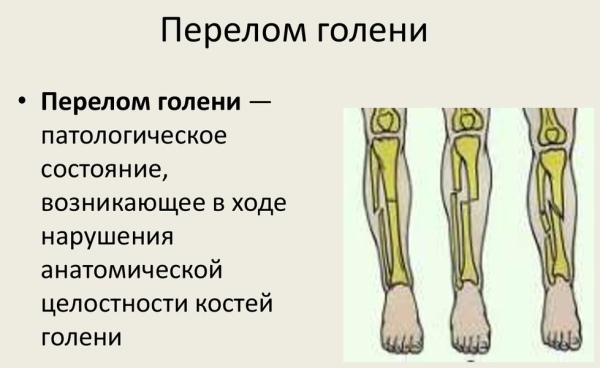Muscular dystonia - This is a pathology in which there is a violation of the development of the muscular system and muscle tone. Most often, it develops in newborns due to pathologies of pregnancy and complicated childbirth, less often in adolescents and adults.
Record content:
- 1 Views
- 2 Stages and degrees
- 3 Symptoms
- 4 Reasons for the appearance
- 5 Diagnostics
- 6 When to see a doctor
- 7 Prophylaxis
-
8 Treatment methods
- 8.1 Medications
-
8.2 Traditional methods
- 8.2.1 Healing baths
- 8.2.2 Aromatherapy with lavender oil
- 8.2.3 Aromatherapy with peppermint oil
- 8.3 Physiotherapy treatment
- 8.4 Water procedures
- 8.5 Massage
- 8.6 Physiotherapy (exercise therapy)
- 8.7 Manual therapy and osteopathy
- 9 Possible complications
- 10 Video about muscle dystonia
Views
Muscular dystonia in infants has several types of classification:
| By the type of muscle tone disorder | |
| Hypertonicity | In the hypertonic form of the pathology, the muscles of the newborn are constantly spasmodic and are in tension even in a relaxed state. |
| Hypotension | With hypotonia, there is a reduced muscle tension and resistance to movement - the muscles are very sluggish and weak. |
| Mixed | With a mixed form, some parts of the body may be spasmodic (hypertonicity), while others, on the contrary, are excessively relaxed (hypotonia). |
By localization and degree of damage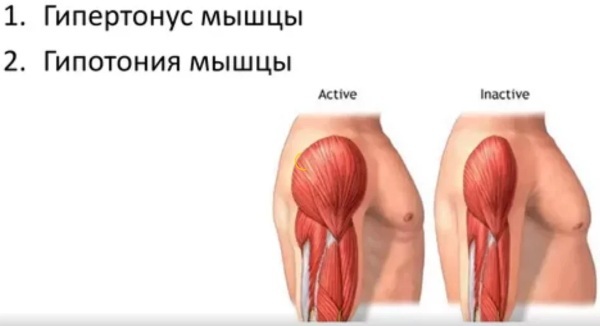 | |
| Local (focal) | It affects a small area of the body, only one muscle or muscle group is susceptible to dystonia. There are also several subspecies of focal dystonia:
|
| Segmental | Manifestations of dystonia are observed in different parts of the body, located nearby. |
| Multifocal | Different parts of the body that are not located next to each other are affected. |
| Hemidystonia | Affects almost all muscles on one side of the body. |
| Generalized | The disease affects all muscles of the body, symptoms appear in any part of it. |
Stages and degrees
There are 5 stages in the development of muscular dystonia:
- Pathology begins to develop, but its symptoms are absent. Usually, signs of dystonia appear several weeks after the birth of a child, less often doctors may notice severe weakness and lethargy of the muscles immediately after childbirth.
- The first signs of dystonia begin to appear: sleep disturbances, frequent crying and screaming. If dystonia is hypotonic, then, on the contrary, the parent notices that the child is too calm.
- Muscle dysfunctions become pronounced (at this stage, parents prefer to see a specialist).
- If the treatment is not started on time, then the child develops a lag in physical development.
- In very severe cases, muscular dystonia results in movement disorders that are almost impossible to correct completely.
Symptoms
Muscular dystonia in infants has different symptoms, depending on the form of the disease.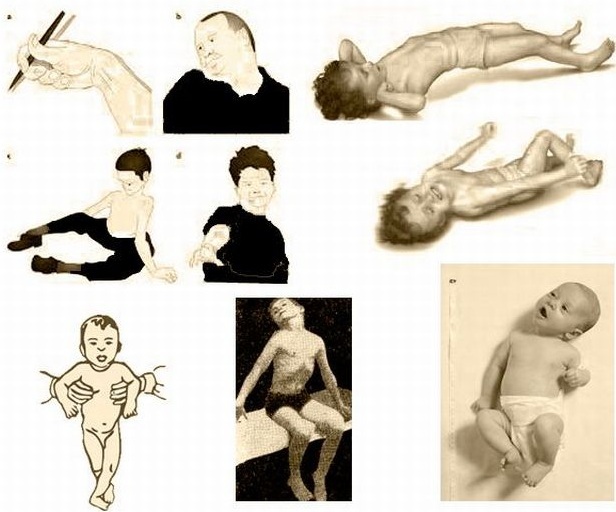
The following symptoms are characteristic of hypertonia:
- the child's arms are most often pressed to the body and it is difficult to straighten them;
- legs are either pressed to the body, or straight and spread apart;
- the child often cries, does not sleep well and falls asleep;
- frequent regurgitation of milk or formula;
- the head is thrown back (due to the fact that the neck muscles are tense);
- there are deformities of the foot.
Slight muscle hypertonia is normal for newborns. In the womb, they are in the fetal position, curled up, and after childbirth they sometimes continue to curl in the same way - this is physiological hypertonicity.
Usually, the signs disappear without a trace by 6 months of a child's life and do not threaten his further development. But if the baby has symptoms of hypertonia pronounced and their predominant amount, then it is necessary to consult a neurologist.
Children with muscle hypotonia are very quiet, calm, rarely cry and hardly move. They have no desire to grab anything, roll over onto their side or stomach, like children without pathologies. If you give a baby with muscle hypotonia a small rattle, then he may not hold it.
Reasons for the appearance
The main causes of muscular dystonia are birth trauma and congenital damage to the child's brain, which lead to impaired development of the muscular system.
Also, pathology can appear as a consequence:
- too much or too little amniotic fluid;
- smoking and drinking alcohol by the mother while carrying the child;
- the effect on the mother's body of toxic substances during pregnancy;
- fetal hypoxia (intrauterine or during childbirth);
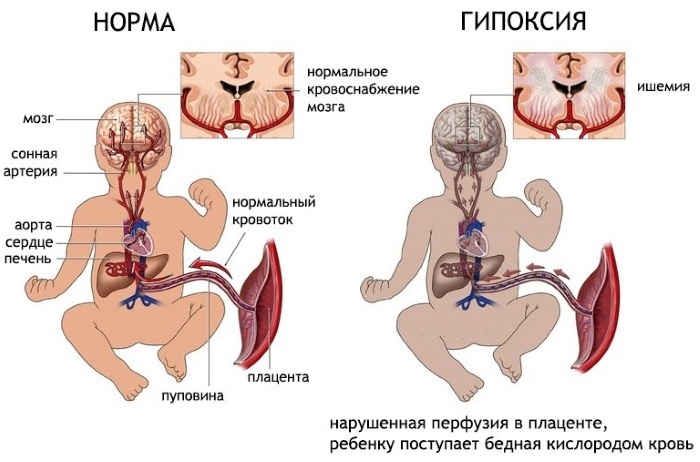
- detachment of the placenta;
- gestosis;
- premature birth or, on the contrary, too long and difficult labor;
- intrauterine infections;
- genetic disorders;
- congenital anomalies of the structure of bones and joints.
Diagnostics
At the first stage of diagnosis, a doctor examines the child, determines the visual signs of dystonia and palpates the muscles. Also, the specialist should ask the parent if the child has a congenital injury or pathology and find out during pregnancy (whether the mother smoked, whether there were infections or serious illnesses during gestation fetus).
There are several methods to help determine the presence of muscular dystonia and its type:
| Limb tone assessment | To determine the muscle tone, the specialist pulls the child's arms up, and spreads the legs to the side, assessing the resistance of the limbs. |
| Muscle symmetry assessment | The doctor puts the undressed baby on his stomach on a hard surface and mentally draws a line from the back of the head to the baby's gluteal fold. With the normal development of the body, the line does not shift, but with pathology it shifts to the side, which indicates the asymmetry of the muscles. |
| Traction test | The child is placed on his back, then taken by the wrists and gently pulled towards himself, lifting. The baby's elbow joints should be straightened, and then he himself should pull himself up with his hands with his whole body. If any stage of the process is absent, this indicates a lack of muscle development.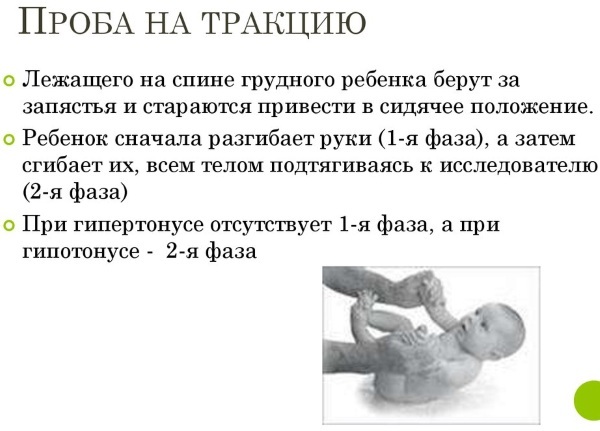
|
| Return symptom | The newborn is placed on its back, and its legs are bent at the knees. Then the doctor unbends the legs and holds them in this position for a while and releases them. If there is no pathology, then the legs should return to their original position, if this does not happen, then this indicates a possible hypotonia of the muscles. |
| Free hanging symptom | The baby is placed on the palm with its stomach down - with normal development, the child keeps his head in line with the body, and his limbs are bent. It is possible to determine the pathology if the arms and legs hang freely, and the child does not hold his head. |
Usually, muscle dystonia can be determined already at 1 examination using diagnostic methods. If necessary, the doctor prescribes additional diagnostic methods: ultrasound or electroencephalography brain to determine the causes of pathology and identify other possible neurological diseases.
You may also need advice from other narrow specialists: traumatologist, orthopedist, surgeon.
When to see a doctor
Muscular dystonia in infants may indicate the presence of more serious diseases (for example, cerebral palsy) or cause developmental disorders in the future. Therefore, when the first signs of pathology are found, it is necessary to visit a neuropathologist.
There are 5 periods of infant development: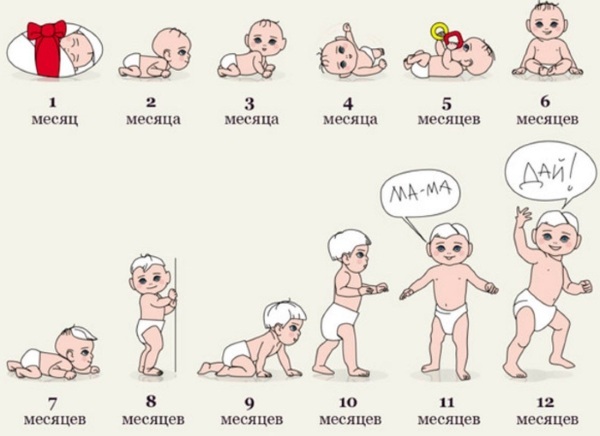
| From birth to 1 month | If the baby is lying on his back, then his arms should be bent at the elbows and pressed to the body, hands clenched into fists. The legs should be slightly bent and spread apart. When lying on your stomach, your arms should be under your chest, and your head should be turned to the side. Towards the end of the period, the infant should try to raise his head on his own and try to hold it for a few seconds. |
| 1-3 months of life | Lying on his back, the child brings his hands to his face, turns his head towards light or sound. Lying on his stomach, an infant at this age can already hold his head for a long time and turn it to the side. The legs are bent, the child makes crawling movements. |
| 3-6 months of life | Lying on your back: arms bent, palms open. The baby actively brings his hands to his face, to the toy and grabs it with his palm. Attempts to sit down appear, the child groups independently. Lying on his stomach: closer to 5 months of age, the child confidently holds his head in the midline, leaning on his forearms. Legs are straightened. |
| 6-9 months of life | By the age of 6 months, the baby easily rolls over from back to stomach. From 7-8 months, he begins to sit down on his own and maintain balance in a sitting position. Lying on his stomach, he can roll over on his back and get on all fours, crawl. By the age of 9 months, the child makes attempts to stand up, holding onto the support. |
| 9-12 months of life | The child actively crawls on all fours, stands confidently near the support. If you need to take something from the floor, then he squats, and then gets up again, holding on to the support. |
The development of each child is individual, and sometimes the child's skills may differ from those that are characteristic of him at a certain age. But if the violations are pronounced (for example, by 5 months the child is not interested in toys and has no reaction to sounds and light), then this is a reason to visit a doctor.
The sooner a pathology is discovered, the higher the chances of curing it without consequences for the further development of the child.
Prophylaxis
Muscular dystonia in newborn babies due to a genetic disorder or birth injury cannot be prevented. But with the help of preventive recommendations, you can reduce the risk of its development, as well as the occurrence of congenital diseases.
Prevention is as follows:
- a pregnant woman should lead a healthy lifestyle - eat rationally, engage in physical activity (if possible), do not smoke or consume alcoholic beverages;

- also, a pregnant woman should regularly visit a gynecologist and undergo medical examinations;
- it is necessary to resort to medical treatment of any pathology during pregnancy only in extreme case and with a balance of benefits and risks (since many drugs have a negative effect on the development fetus);
- at the risk of any pathology during pregnancy or an already diagnosed complication, it is imperative to follow all the doctor's recommendations and, if necessary, be hospitalized.
- after childbirth, you need to visit all the necessary pediatric doctors in accordance with the schedule.
Treatment methods
Muscular dystonia is treated in a complex way with the help of medicines, massage, physiotherapy exercises and other methods, depending on its type. The therapy is aimed at strengthening the child's muscular system, relieving or increasing tone, and preventing complications.
Medications
Drug therapy for muscle dystonia is selected strictly individually, depending on the reasons, the type of pathology, the age of the child and the individual characteristics of his body.
In case of hypertonicity, drugs are prescribed that reduce the increased muscle tone and contribute to their relaxation (muscle relaxants): "Mydocalm", "Nimbex".
In case of hypotonia, drugs are needed to increase muscle tone and improve neuromuscular transmission - infants are allowed only "Encephabol".
Also, a neurologist may prescribe a vitamin B preparation (thiamine chloride), as it improves brain function and contributes to the normal development of the muscular system. For infants, drugs are prescribed mainly in the form of injections.
Traditional methods
Traditional methods in the treatment of muscular dystonia help to eliminate excessive muscle tension, improve blood circulation in the tissues. Before using this or sometimes method, it is necessary to consult a doctor.
Healing baths
With a high muscle tone of the baby, it is useful to bathe in a bath with the addition of chamomile infusion.
To prepare the product, you must:
- Pour 2 tbsp. l. dry chamomile flowers 500 ml of hot water (temperature not higher than 80 degrees) and infuse the mixture for 30 minutes.
- Then the infusion must be filtered and poured into a pre-selected bath and the child should be bathed in it for 10-12 minutes.
- After that, you need to let the water dry naturally on the child's body.
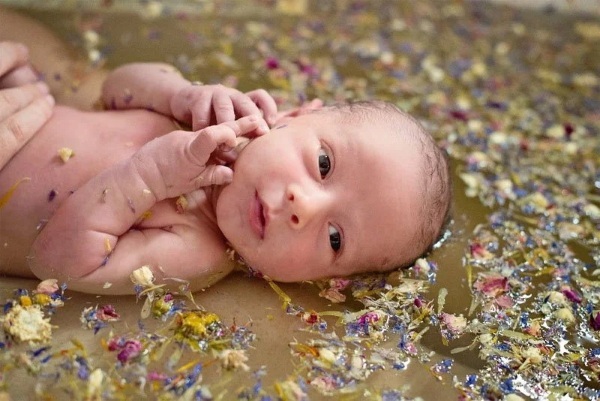
The course of treatment is 10 procedures that must be performed daily. The use of chamomile baths also helps to eliminate anxiety in the child and to improve his sleep.
Aromatherapy with lavender oil
Lavender essential oil also helps relieve muscle tension, improve baby sleep and eliminate unnecessary anxiety. For aromatherapy, you can use special lamps or candles that need to be lit in 1.5-2 hours. before putting the child to bed. For one aromatherapy session, 1-2 drops of oil are enough. The course of treatment is 5-7 days, the procedure should be performed daily.
Aromatherapy with peppermint oil
Peppermint oil has a tonic effect and is beneficial for newborns with muscle hypotonia. Regular sessions of aromatherapy with this type of oil enhance blood microcirculation in body tissues, activate receptors, and eliminate lethargy.
Treatments with mint oil do not differ in the way they are carried out from aromatherapy with lavender oil, but they must be performed in the morning due to their tonic properties.
Physiotherapy treatment
Physiotherapy for muscular dystonia has the following effect:
- improves neuromuscular conduction;
- enhances blood circulation in tissues and improves their nutrition;
- eliminates painful sensations;
- stimulates tissue regeneration;
- relieves muscle spasms;
Depending on the type and cause of the pathology, physiotherapeutic methods may be prescribed locally on the affected muscles or on the head area to affect the brain.
For muscular dystonia, the following physiotherapy procedures are effective:
- thermotherapy;
- electrophoresis (can be prescribed both locally to the affected muscles and to the head area);

- ultrasound therapy;
- magnetotherapy;
- alternate heat and cold treatment;
- electromyostimulation;
- mud applications.
Water procedures
Hydrotherapy refers to physiotherapy and, in turn, has several varieties.
When infantile muscular dystonia is used:
- hydromassage;
- mineral baths;
- phytovannes (with the addition of medicinal herbs);
- therapeutic rubdown;
- therapeutic swimming.
Water therapy helps to eliminate muscle spasm and promotes deep relaxation, improves blood circulation in tissues, and relieves pain. Also, regular water treatments improve sleep, relieve anxiety, and some therapies help to increase muscle tone and mobility.
Massage
Massage is one of the main and most effective treatments for muscular dystonia. It is aimed at relaxing the muscles (with hypertonicity) or stimulating them (with hypotonia).
Depending on the type of violations, the masseur commits:
- patting;
- shaking;
- stroking;
- pressing on certain points and stimulating them;
- rubbing;
- tapping;
- pinching.
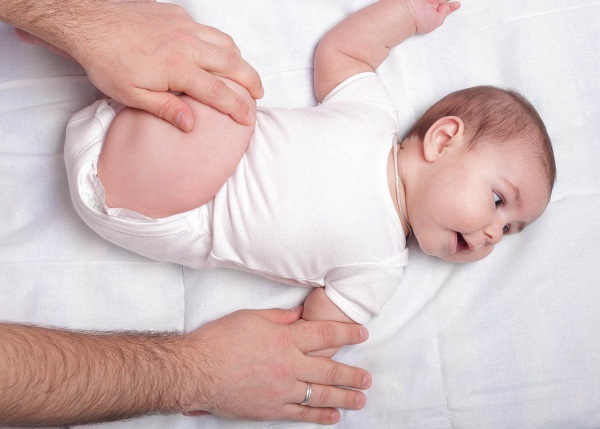
Massages are carried out in courses 2 times a year for 7-12 procedures. You should not massage the child on your own, since due to ignorance of the structures of the child's body, even more harm can be done when performing manipulations. For the same reason, it is worth choosing a child masseur, since he knows all the features of the child's body.
Physiotherapy (exercise therapy)
Exercise therapy strengthens muscles and promotes healthy development of the musculoskeletal system. Babies are prescribed gymnastics with a minimum load - swinging, bending and extending the limbs, stretching or exercising on a fitball.
Also, with muscle dystonia, water gymnastics is often prescribed - a child with a swimming ring worn around his neck is immersed in a pool and, holding it, perform exercises with his muscles. Classes are taught by an infant swimming instructor. Over time, the duration of the procedure is increased, and after a few months of training, the swimming ring is removed.
Manual therapy and osteopathy
Manual therapy is a method of treatment based on the direct action of the hands of a specially trained doctor on the muscles and ligaments of the patient. This method resembles massage, but differs from it in a deeper study of the elements of the musculoskeletal system.
With muscular dystonia in an infant, a chiropractor will be able to eliminate deep spasms, stimulate the restoration of muscle tissue.
Osteopathy refers to manual therapy, but differs from it in that the doctor looks for the cause of a particular pathology and treats it. For example, if cervical muscular dystonia is caused by a clamping or curvature of the vertebra, then the doctor will be able to detect this pathology by manual action on the child's body and eliminate it.
The duration of the course of manual therapy is selected individually, depending on the severity of the pathology. In most cases, 1-3 sessions are sufficient with an interval of several days.
Possible complications
Muscular dystonia in infants, if untreated, will progress and in the future may cause the following complications:
- curvature of the spine (kyphosis or scoliosis);
- violation of posture;
- clubfoot;
- lameness;
- Difficulty learning writing and other skills that involve hands.
In severe cases, due to muscle tone disorders, cerebral palsy can develop.
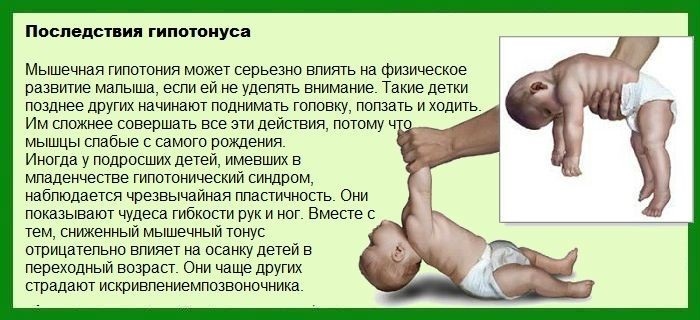
A child with dystonia will have difficulties not only in the educational, but also in the everyday sphere. Also, due to health problems, he may experience severe stress, which will negatively affect his psyche.
Muscular dystonia can be completely cured if treatment is started early (up to 1 year of age). If an infant has 2-3 signs of dystonia, then it is necessary to visit a neurologist in order to prevent the progression of the disease.
Video about muscle dystonia
Does a child need massage for muscle hypertonicity:

